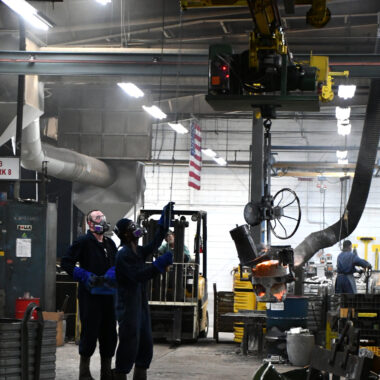Opening the Prospective of Aluminum Spreading: A Comprehensive Summary
Aluminum casting stands as a cornerstone in the world of metalworking, providing a plethora of advantages and applications across different markets. As we browse with the landscape of aluminum casting processes and dive right into the intricacies of top quality control procedures, a comprehensive review of unlocking the true potential of this metal arises.

Background of Light Weight Aluminum Casting
Aluminum spreading has an abundant historic history that goes back to old worlds, showcasing the enduring importance of this metallurgical procedure in various sectors. The roots of light weight aluminum casting can be mapped to around 5,000 B.C. when ancient worlds like the Egyptians and the Sumerians made use of rudimentary techniques to cast small things. It was not till the 19th century that light weight aluminum casting saw substantial innovations with the exploration of the Hall-Héroult process for removing aluminum from its ore, making it a lot more accessible for casting purposes.
During the Industrial Revolution, light weight aluminum casting gained extensive appeal due to the steel's lightweight buildings and rust resistance. This caused its extensive usage in making parts for various sectors, consisting of automobile, aerospace, and building. The versatility of aluminum casting enabled intricate forms and intricate styles to be generated with precision, further fueling its fostering across various industries. Today, aluminum spreading remains to be a keystone in the production of a vast array of products, highlighting its enduring tradition and value in modern production processes.
Advantages and Applications
With its remarkable strength-to-weight ratio and outstanding thermal conductivity, aluminum spreading supplies a myriad of benefits and varied applications across numerous markets. One of the key benefits of light weight aluminum casting is its light-weight nature, making it an excellent choice for sectors where weight decrease is crucial, such as vehicle and aerospace.
In terms of applications, light weight aluminum casting is extensively made use of in the automobile industry for elements like engine blocks, cyndrical tube heads, and wheels due to its strength and light-weight residential or commercial properties. The flexibility of aluminum casting extends to consumer electronics, where it is utilized in the production of housings and warm sinks.
Sorts Of Light Weight Aluminum Spreading Processes

Among the different methods utilized in commercial settings, light weight aluminum casting procedures encompass an array of techniques fit to various applications and requirements. Financial investment casting, also recognized as lost-wax spreading, is favored for its capability to produce elaborate and detailed parts with a smooth surface area finish. Each of these aluminum spreading processes offers special benefits, providing to a wide variety of commercial demands.
Innovations in Light Weight Aluminum Spreading Techniques
Recent developments in light weight aluminum casting techniques have revolutionized the production market, providing improved efficiency and precision in the production of facility elements. One useful content remarkable technology is the growth of 3D sand printing technology, which enables the development of complex sand mold and mildews with very little hand-operated labor. This strategy enables higher style versatility and faster manufacturing cycles, making it perfect for prototyping and little batch manufacturing.
Additionally, making use of innovative simulation software has actually significantly boosted the casting process by making it possible for designers to enhance mold styles and forecast potential flaws prior to manufacturing begins (casting aluminum). This leads to boosted product high quality and decreased material waste
In addition, the adoption of vacuum-assisted aluminum casting has improved the general quality of castings by decreasing porosity and making certain an extra uniform distribution of molten metal. This strategy is particularly advantageous for components that need high structural stability and exceptional surface area finish.
Quality Assurance in Aluminum Spreading
The improvements in aluminum casting strategies have not only boosted performance and accuracy but have actually additionally highlighted the important value of quality control in guaranteeing the reliability and efficiency of actors components. Quality control in aluminum spreading includes a systematic method to keep track of and assess the manufacturing process, identifying any type of deviations from established standards that can affect the end product.
One critical aspect of quality assurance is making use of innovative technologies such as non-destructive testing techniques like X-ray and ultrasound to find internal flaws without compromising the stability of the actors parts. Furthermore, applying strenuous inspection protocols at various stages of production helps in determining and fixing issues promptly, ensuring that only elements satisfying the specified standards are released for usage.
Furthermore, quality assurance prolongs beyond the production procedure to include post-casting procedures like warm treatment and surface ending up, assuring that the end products meet the desired requirements. By prioritizing quality assurance steps, producers can improve item consistency, durability, and overall consumer satisfaction in the world of aluminum spreading.
Conclusion
Various types of casting processes and innovative techniques have been established to boost the effectiveness and top quality check my site of aluminum spreading. Generally, aluminum spreading proceeds to be a valuable production procedure with fantastic potential for more innovations in the future.
As important link we browse via the landscape of light weight aluminum casting processes and delve into the details of quality control actions, an extensive overview of unlocking the real potential of this metal emerges. It was not up until the 19th century that light weight aluminum spreading saw substantial innovations with the discovery of the Hall-Héroult process for extracting light weight aluminum from its ore, making it extra easily accessible for casting objectives.
Amongst the numerous approaches used in industrial settings, aluminum spreading procedures incorporate a variety of methods fit to different applications and demands. Investment casting, additionally understood as lost-wax spreading, is preferred for its capability to create detailed and detailed parts with a smooth surface finish. Various kinds of casting processes and cutting-edge techniques have been created to boost the performance and top quality of light weight aluminum casting.
Comments on “Accomplish Excellence: Advanced Techniques in Casting Aluminum”